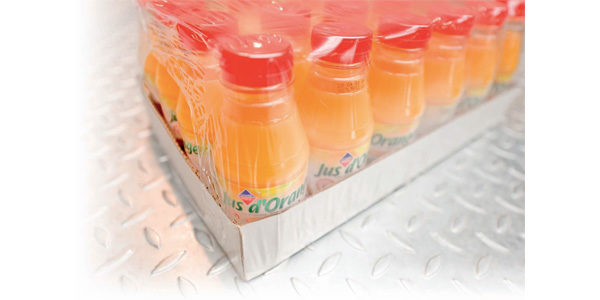Distribution juiced to the max

Manufacturing growth is usually a good thing. But it can cause headaches for the distribution end of the operation. Argozumos, a Spanish provider of juice products and a subsidiary of Germany's riha Group, managed to avoid that trap when it had to make changes at its bottling facility in Lekunberri, Spain, to accommodate increases in production. Basically, it took pre-emptive action by addressing its distribution needs at the same time it added new filling capacity.
Since its founding in 1981, Argozumos has sought to be innovative with its juice products. It was the first to introduce soft-pack juices to the Spanish market and recently became the first bottler in its country to install an aseptically filled juice line. The new PET-Asept-D line uses a dry process that sterilizes plastic juice containers using gaseous hydrogen peroxide instead of water. (The facility is limited in the amount of wastewater it can discharge.)
The innovative juice line was completed in 2008 at the Lekunberri distribution center, located in northern Spain about 20 miles from Pamplona. Sales of juices in the plastic PET bottles have since surpassed sales of cartoned juices.
In order to accommodate the added production volumes from the new line, some changes to the distribution end of the building would be needed. Products had been floor-stored on pallets prior to the addition of the new line, but the number of available locations in the warehouse was limited. Some new space would have to be found—and fast.
Argozumos looked to Krones for an answer. For decades, Krones has been known as a leading equipment supplier in the beverage, food packaging, and processing industries, and it was, in fact, the provider of the new aseptic filling line at Lekunberri. But Krones also designs and supplies distribution equipment, including automated storage systems. Krones says that because production increases often translate into distribution challenges, it takes a holistic approach to logistics, offering its customers systems that integrate the two aspects.
What Argozumos told Krones it wanted was a solution that would not only add critical space for storage, but also provide a high degree of inventory accuracy while reducing damage compared with manual handling. The solution also had to be a system that could be installed without disrupting the production or distribution flow of the existing operations. The company did not have the luxury of shutting down operations while the installation took place.
The solution Krones came up with for Argozumos included a high-bay warehouse with an automated storage and retrieval system (AS/RS).
To house the new system, a rack-supported building (76 meters long by 37 meters wide by 29 meters high, or 250 by 121 by 95 feet) was added on to the facility. The racking provides very dense storage compared with the former block warehouse. In the block warehouse, products were stored on the floor or in small stacks, which resulted in the waste of vertical space. The amount of available storage space was further reduced by the need to allow room for lift trucks to maneuver within the building.
"We were able to dimension the high-bay warehouse as a correspondingly smaller and more affordable building," says Christian Theis, managing director of operations for the riha Group.
The AS/RS inside the building features five aisles served by five automated cranes that gather pallets or half-sized pallets of products for deposit into 14,060 double-deep storage locations. The cranes are able to handle 165 pallets per hour.
KEEPING THE JUICES FLOWING
Production in the facility takes place seven days a week on six carton lines, a glass bottle line, a standard plastic-bottle PET line, and the new aseptic PET line. The new line alone is designed to produce up to 25,000 containers an hour. Overall, the facility manufactures about 400 different SKUs, defined by various juice blends, packaging types, sizes, and so forth.
Finished products coming from the bottling machines are shrink-wrapped into six-packs or 24-bottle trays and then palletized onto either full-sized pallets or half-sized Euro pallets. Once the packaging and palletizing is completed, control is handed over to the facility's new warehouse management system (WMS), also supplied by Krones as part of the upgrade.
The WMS controls the inventory in the automated warehouse as well as the former floor-stored space that's now used for overflow and bulk storage. In addition to processing the company's own branded juices, the new warehouse management system helped make it possible for Argozumos to expand its production of private-label juice products for Europe's major food retailers and perform co-packing within its facility. The new automated warehouse has the capacity to easily handle the storage needs for these other operations as well.
From production, the palletized loads are conveyed to vertical lifts that raise the loads about 15 feet above floor level, where they are transferred to conveyors. (Designing these conveyors to run overhead allows for greater flexibility in the use of the valuable floor space below, such as reconfiguring or adding new production lines in the future.) The pallets are then conveyed to the adjacent rack-supported building. The automated system is designed to handle 146 pallets an hour from production, plus as many as 60 pallets per day that come in from other facilities. These outside products will be co-packed with juices produced in Lekunberri.
As pallets arrive in the high-bay area, a contour and pallet inspector automatically checks them to make sure they're suitable for use in the AS/RS, with no hanging edges or broken parts. Rejected pallets are diverted to a spur for repair. The five cranes of the AS/RS then gather suitable loads for transport to the double-deep storage locations. Eighty percent of the loads are on half-pallets slaved together for storage. The warehouse provides enough of a storage buffer for a two-week turn in products. With the automation, however, a goal is to eventually provide more just-in-time distribution of products, so that dwell time will be reduced.
When needed for orders, a full pallet or half pallet is pulled by the cranes and taken to a drop-off station. The system can retrieve 165 pallets an hour. From there, shuttle transfer cars and conveyors transport the pallets to the shipping area, where 12 lanes await. The system is designed with swivels within the conveyor that can turn the pallet for loading with either the long or short edge leading. Some pallets will be loaded immediately onto outbound trucks for just-in-time processing, while other items will be staged for shipping. Loading is conducted on two shifts, with the warehouse management system helping to keep the workload balanced. Over 60 trucks can be loaded daily.
While 95 percent of products ship as either a full or half pallet, the remaining 5 percent of products ship as pallets with mixed cases. The new AS/RS has made it much easier to pick cartons for these mixed-case loads. Pallets are retrieved from the storage system and taken to a small picking area, where workers remove cartons for orders as directed by handheld terminals. The source pallet is then sent back to the AS/RS until needed for further picking.
The finished mixed pallets are either sent directly to shipping or sent to the AS/RS for temporary storage until the truck assigned to that order is ready to be loaded. The ability to store completed orders before shipping means that products for those orders can be picked in advance. This allows for more flexibility in balancing the picking workload throughout the facility's single picking shift. When the loads are ready to ship, these pallets are retrieved easily from the AS/RS in sequence for ordered loading. Products can also be sent from the AS/RS to the old block warehouse, which has 4,000 storage positions for overflow needs.
JUICED FOR THE FUTURE
The addition of the new production lines has allowed Argozumos to expand its offerings, while the automation in the distribution side of the business has streamlined its processes and improved the handling of its products. Altogether, the production lines and distribution operation account for 250 million juice units annually.
The AS/RS and new warehouse management system have contributed greatly to those output volumes. They have combined to reduce labor costs, increase speeds, improve product availability, and reduce damage. The automated systems and conveyors have also cut down on lift truck traffic on the facility floor, while placing conveyors overhead has reduced congestion.
The automated storage also provides the capacity needed for current and future growth. Three more aisles can be added to the system if needed, which would boost the operation's storage space by about 60 percent.
Related Articles

Copyright ©2024. All Rights ReservedDesign, CMS, Hosting & Web Development :: ePublishing